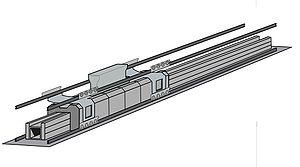Electromagnetic Aircraft Launch System
The Electromagnetic Aircraft Launch System ( EMALS , German: electromagnetic aircraft launch system ) is an aircraft catapult for aircraft carriers that is currently under development and is to be used for the first time on ships of the Gerald R. Ford class .
construction
Linear motor
The heart of the catapult is a linear motor which , in contrast to conventional electric motors, does not generate a rotary motion, but a straight linear motion in order to drive the carriage to accelerate the aircraft. The linear motor consists of a row of 64 cm long stator coils that are controlled sequentially and thus move the starting slide along the track. Hall sensors are used to determine the position of the slide . The movable starter slide is mounted on the side by means of rollers and has 160 neodymium magnets .
Energy storage system
The starting process requires a higher electrical output (approx. 50 MW ) for a short time than the energy supply of the ship can provide. Therefore, energy is temporarily stored in a flywheel storage device, which can then be called up again within a very short time. At EMALS , four flywheels are available for this. They are accelerated to a speed of 6400 min −1 and then each store 121 MJ (33.6 kWh ). To compensate for the gyroscopic forces caused by the centrifugal masses, two flywheels are always arranged in pairs and in opposite directions. Charging takes 45 seconds. Despite the high level of efficiency, the high amount of energy converted creates a lot of heat that has to be dissipated by means of liquid cooling.
Energy conversion
Electrical energy retrieved from the energy storage system is converted by an inverter into voltage pulses with alternating polarity, which generate electrical currents that are adapted to the position and speed of the launch carriage. The frequency increases during the starting process from virtually 0 to 640 Hz , the voltage from 0 to 1520 V. The maximum current is 6400 A.
Project status
- June 1, 2010: A T-45 Goshawk launched from Naval Air Engineering Station Lakehurst .
- June 9, 2010: A C-2 Greyhound launch from Naval Air Engineering Station Lakehurst.
- December 18, 2010: Launch of an F / A-18E Super Hornet from Naval Air Engineering Station Lakehurst.
- September 27, 2011: E-2D Advanced Hawkeye launch from Naval Air Engineering Station Lakehurst.
- November 18, 2011: Launch of an F-35C .
advantages
Compared to conventional steam-powered catapults that has EMALS a higher efficiency . The elimination of steam generators, hydraulics and pneumatics also simplifies the structure and thus lowers maintenance costs, and the noise level generated is also significantly reduced. Thanks to the precise controllability of the take-off process, the catapult can be tailored precisely to the needs of a wide range of aircraft. In addition, the maximum start frequency increases.
commitment
EMALS is being developed for the Gerald R. Ford class aircraft carriers , but Great Britain is also planning to use electromagnetic launch catapults for its new Queen Elizabeth class aircraft carriers . For reasons of cost and time, however, it was ultimately waived and the Queen Elizabeth class is built with a conventional ski jump .
Westinghouse Electric carried out first attempts with EM catapults as early as 1946 with the Electropult .
Web links
Individual evidence
- ↑ a b c edn.com: how it works. (PDF; 80 kB) (No longer available online.) Archived from the original on May 25, 2011 ; Retrieved February 28, 2012 . Info: The archive link was inserted automatically and has not yet been checked. Please check the original and archive link according to the instructions and then remove this notice.
- ↑ a b c globalsecurity.org: Electromagnetic Aircraft Launch System - EMALS. Retrieved February 28, 2012 .
- ↑ US Navy: EMALS launches first Goshawk. Retrieved February 28, 2012 .
- ↑ US Navy: EMALS successfully launches first Greyhound. Retrieved February 28, 2012 .
- ^ Patriotspoint.org: First Magnetic Launch of Naval Aircraft. Retrieved February 28, 2012 .
- ↑ upi.com: New carrier launch system tested. Retrieved February 28, 2012 .
- ↑ defensetech.org: F-35C Launches From EMALS . Retrieved February 28, 2012 .
- ↑ a b Tim Fish: Converteam develops catapult launch system for UK carriers. (No longer available online.) Archived from the original on December 29, 2011 ; Retrieved February 28, 2012 . Info: The archive link was inserted automatically and has not yet been checked. Please check the original and archive link according to the instructions and then remove this notice.
- ↑ Eric R. Laithwaite: Propulsion without wheels. English Univ. Press, London 1966, not yet an ISBN, pp. 148–151.
- ↑ Electric slingshot launches plan Popular Science in November 1946, @ google books

